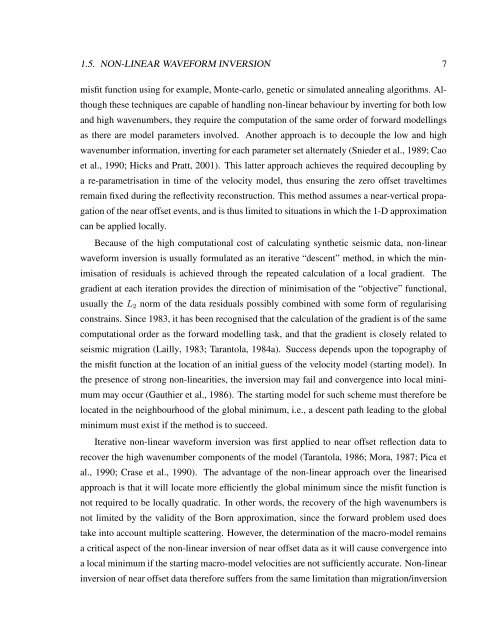Sirgue, Laurent, 2003. Inversion de la forme d'onde dans le ...
Sirgue, Laurent, 2003. Inversion de la forme d'onde dans le ...
Sirgue, Laurent, 2003. Inversion de la forme d'onde dans le ...
You also want an ePaper? Increase the reach of your titles
YUMPU automatically turns print PDFs into web optimized ePapers that Google loves.
1.5. NON-LINEAR WAVEFORM INVERSION 7<br />
misfit function using for examp<strong>le</strong>, Monte-carlo, genetic or simu<strong>la</strong>ted annealing algorithms. Although<br />
these techniques are capab<strong>le</strong> of handling non-linear behaviour by inverting for both low<br />
and high wavenumbers, they require the computation of the same or<strong>de</strong>r of forward mo<strong>de</strong>llings<br />
as there are mo<strong>de</strong>l parameters involved. Another approach is to <strong>de</strong>coup<strong>le</strong> the low and high<br />
wavenumber information, inverting for each parameter set alternately (Snie<strong>de</strong>r et al., 1989; Cao<br />
et al., 1990; Hicks and Pratt, 2001). This <strong>la</strong>tter approach achieves the required <strong>de</strong>coupling by<br />
a re-parametrisation in time of the velocity mo<strong>de</strong>l, thus ensuring the zero offset traveltimes<br />
remain fixed during the ref<strong>le</strong>ctivity reconstruction. This method assumes a near-vertical propagation<br />
of the near offset events, and is thus limited to situations in which the 1-D approximation<br />
can be applied locally.<br />
Because of the high computational cost of calcu<strong>la</strong>ting synthetic seismic data, non-linear<br />
waveform inversion is usually formu<strong>la</strong>ted as an iterative “<strong>de</strong>scent” method, in which the minimisation<br />
of residuals is achieved through the repeated calcu<strong>la</strong>tion of a local gradient. The<br />
gradient at each iteration provi<strong>de</strong>s the direction of minimisation of the “objective” functional,<br />
usually the L 2 norm of the data residuals possibly combined with some form of regu<strong>la</strong>rising<br />
constrains. Since 1983, it has been recognised that the calcu<strong>la</strong>tion of the gradient is of the same<br />
computational or<strong>de</strong>r as the forward mo<strong>de</strong>lling task, and that the gradient is closely re<strong>la</strong>ted to<br />
seismic migration (Lailly, 1983; Taranto<strong>la</strong>, 1984a). Success <strong>de</strong>pends upon the topography of<br />
the misfit function at the location of an initial guess of the velocity mo<strong>de</strong>l (starting mo<strong>de</strong>l). In<br />
the presence of strong non-linearities, the inversion may fail and convergence into local minimum<br />
may occur (Gauthier et al., 1986). The starting mo<strong>de</strong>l for such scheme must therefore be<br />
located in the neighbourhood of the global minimum, i.e., a <strong>de</strong>scent path <strong>le</strong>ading to the global<br />
minimum must exist if the method is to succeed.<br />
Iterative non-linear waveform inversion was first applied to near offset ref<strong>le</strong>ction data to<br />
recover the high wavenumber components of the mo<strong>de</strong>l (Taranto<strong>la</strong>, 1986; Mora, 1987; Pica et<br />
al., 1990; Crase et al., 1990). The advantage of the non-linear approach over the linearised<br />
approach is that it will locate more efficiently the global minimum since the misfit function is<br />
not required to be locally quadratic. In other words, the recovery of the high wavenumbers is<br />
not limited by the validity of the Born approximation, since the forward prob<strong>le</strong>m used does<br />
take into account multip<strong>le</strong> scattering. However, the <strong>de</strong>termination of the macro-mo<strong>de</strong>l remains<br />
a critical aspect of the non-linear inversion of near offset data as it will cause convergence into<br />
a local minimum if the starting macro-mo<strong>de</strong>l velocities are not sufficiently accurate. Non-linear<br />
inversion of near offset data therefore suffers from the same limitation than migration/inversion

















